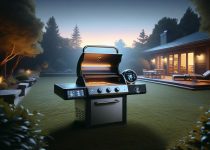Expert’s Guide: Winter BBQ Meat Techniques
Are you ready to take your winter BBQ game to the next level? Look no further than this expert’s guide on winter BBQ meat techniques.
In just a few paragraphs, you’ll discover the secrets to choosing the right cuts, preparing the grill, and achieving that perfect smoky flavor.
With tips on seasoning, temperature control, and resting techniques, you’ll be the BBQ hero of the season.
So grab your apron and get ready to impress your friends and family with mouthwatering winter BBQ creations.
Table of Contents
Key Takeaways
- Choosing the right cuts of meat and considering tenderness and marbling is essential for a successful winter BBQ.
- Proper grilling surface preparation and preheating are important for even cooking and preventing food from sticking.
- Seasoning and marinating the meat can enhance flavor and tenderness.
- Controlling the temperature and heat management are crucial for achieving desired doneness and ensuring even cooking.
Choosing the Right Cuts
To choose the right cuts for your winter BBQ, consider the tenderness and marbling of the meat. The tenderness of the meat refers to how easily it can be chewed and enjoyed. Different cuts have varying levels of tenderness, so it’s important to choose one that suits your preferences. For example, ribeye steaks are known for their tenderness and are a popular choice for BBQs. On the other hand, tougher cuts like beef brisket require longer cooking times to break down the tough fibers and become tender.
Another factor to consider is the marbling of the meat. Marbling refers to the fat content within the muscle fibers. The fat adds flavor and moisture to the meat, making it more succulent and delicious. Cuts with higher marbling, such as ribeye or striploin, are ideal for BBQs as the fat melts during cooking, infusing the meat with rich flavors.
In addition to tenderness and marbling, brining methods can also enhance the flavor and moisture of the meat. Brining involves soaking the meat in a saltwater solution before cooking. This process helps to season and tenderize the meat, resulting in a juicier and more flavorful BBQ experience.
When it comes to cooking times, it’s essential to follow the recommended guidelines for each cut of meat. Different cuts require different cooking times to achieve the desired level of doneness. Overcooking can result in dry and tough meat, while undercooking can be unsafe to eat. Therefore, it’s important to use a meat thermometer and follow cooking time recommendations to ensure your winter BBQ is a success.
Preparing the Grill
Now that you’ve chosen the right cuts for your winter BBQ, it’s time to get your grill ready.
To ensure optimal temperature control, start by checking your grill’s knobs and vents for any blockages or malfunctions.
Next, give your grilling surface a good scrub to remove any residue from previous use.
Temperature Control Tips
How can you ensure precise temperature control when preparing the grill for your winter BBQ?
One important factor is to have a good understanding of smoke flavoring and indirect grilling. Start by setting up your grill for indirect cooking, which involves placing the meat on one side of the grill and heating the other side. This technique allows for slower and more even cooking, resulting in tender and flavorful meat.
To control the temperature, adjust the vents on your grill. Opening the vents allows more oxygen to enter, increasing the heat, while closing them reduces the airflow and lowers the temperature.
It’s also important to monitor the internal temperature of the grill using a thermometer.
Grilling Surface Preparation
One key aspect of preparing the grill for your winter BBQ is ensuring the grilling surface is properly prepped. To ensure a safe and enjoyable grilling experience, follow these cleaning techniques and grilling safety tips:
-
Clean the grates: Scrub the grates thoroughly with a wire brush to remove any food residue or grease buildup.
-
Check for rust: Inspect the grates for any signs of rust. If rust is present, use sandpaper to remove it before grilling.
-
Oil the grates: To prevent food from sticking, lightly coat the grates with oil using a brush or spray.
-
Ensure proper ventilation: Before lighting the grill, ensure that the vents are clear and unobstructed for optimal airflow.
Preheating Time Recommendations
Wondering when to start preheating your grill for your winter BBQ? The preheating time for your grill depends on the type of meat you will be grilling. Different meats require different cooking temperatures, so it’s important to preheat your grill accordingly. Here are some general preheating time recommendations to ensure your winter grilling is a success:
| Meat Selection | Preheating Time |
|---|---|
| Steaks | 10-15 minutes |
| Chicken | 15-20 minutes |
| Pork Chops | 15-20 minutes |
| Fish | 5-10 minutes |
Seasoning and Marinating
To enhance the flavor and tenderness of your winter BBQ meat, it’s essential to properly season and marinate it. Seasoning and marinating not only add delicious flavors but also help to lock in moisture and create a mouthwatering crust when cooked on the grill.
Here are some key techniques to consider:
-
Smoke Infusion: Adding a smoky flavor to your winter BBQ meat can take it to the next level. Consider using wood chips or chunks to create smoke during the cooking process. This will infuse your meat with a rich and aromatic taste that will have your guests coming back for more.
-
Brining Techniques: Brining involves soaking your meat in a mixture of salt, sugar, and water. This process helps to tenderize the meat and enhance its natural flavors. It also helps to retain moisture, ensuring that your winter BBQ meat stays juicy and succulent.
-
Dry Rubs: Dry rubs are a mixture of herbs, spices, and seasonings that are applied directly to the meat before cooking. They add layers of flavor and create a delicious crust on the outside of the meat. Experiment with different combinations to find your favorite blend.
-
Marinades: Marinades are a combination of liquids, such as oil, vinegar, and citrus juices, along with herbs, spices, and other flavorings. They’re used to infuse the meat with flavor and tenderize it. Allow your meat to marinate for at least a few hours or overnight to maximize the flavor infusion.
Controlling the Temperature
Now let’s talk about how to control the temperature when grilling in the winter.
It’s important to manage the heat properly to ensure your meat cooks evenly and to your desired level of doneness.
You’ll also want to make use of a reliable thermometer to monitor the internal temperature of your meat.
Lastly, keep in mind that colder weather presents its own set of challenges, so be prepared to make adjustments as needed.
Heat Management Tips
Mastering heat management is crucial for achieving perfectly cooked BBQ meat during the winter months. Here are some tips to help you control the temperature and get that delicious smoke flavor:
-
Fuel selection: Choose the right type of fuel for your smoker. Different fuels, such as charcoal, wood pellets, or hardwood logs, will produce different levels of heat and smoke flavor. Experiment with different options to find what works best for you.
-
Fire management: Build a fire that will last for the duration of your cook. Start with a small amount of fuel and gradually add more as needed. Keep an eye on the temperature and adjust the airflow to maintain a consistent heat level.
-
Ventilation: Proper ventilation is essential for regulating the temperature. Adjust the dampers or vents on your smoker to control the amount of air flowing in and out. More air means higher heat, while less air will lower the temperature.
-
Monitoring: Use a reliable thermometer to monitor the temperature inside the smoker. Keep an eye on both the cooking temperature and the internal temperature of the meat to ensure it’s cooked to perfection.
Thermometer Usage Tricks
Use one thermometer to easily control the temperature of your BBQ meat during the winter months.
To ensure thermometer accuracy, calibrate it before each use. Fill a glass with ice water and insert the probe. The reading should be close to 32°F (0°C). If not, adjust the thermometer accordingly.
Troubleshooting thermometers is essential for accurate temperature control. If the thermometer reads higher or lower than expected, check for any obstructions or damage to the probe. Clean the probe with warm soapy water, and ensure it’s inserted into the thickest part of the meat without touching bone or fat.
For large cuts of meat, consider using a leave-in thermometer to constantly monitor the temperature without repeatedly opening the grill.
Cold Weather Challenges
To effectively control the temperature of your BBQ meat in cold weather, use a reliable thermometer and make adjustments as necessary.
Cold weather can present some challenges when it comes to maintaining the perfect temperature for your meat. Here are a few tips to help you overcome these challenges:
-
Winter grilling safety precautions: It’s important to ensure that you’re grilling in a safe environment, especially in colder weather. Keep your grill away from any flammable materials and make sure it’s stable on a level surface.
-
Maintaining flavor in cold weather conditions: Cold weather can affect the flavor of your meat, so it’s important to take extra steps to maintain its delicious taste. Consider marinating your meat for a longer period of time to enhance the flavors, and use a good quality wood or charcoal for that smoky flavor.
Smoking and Wood Selection
Get the most flavor out of your winter BBQ meats by selecting the right wood and mastering the art of smoking. The type of wood you choose plays a crucial role in the taste and aroma of your smoked meats. Different wood types impart unique flavors, so it’s important to select the one that complements your chosen meat. Here is a table highlighting some popular wood types and their characteristics:
| Wood Type | Flavor Profile |
|---|---|
| Mesquite | Strong and bold |
| Apple | Sweet and fruity |
| Hickory | Rich and smoky |
| Oak | Nutty and robust |
To achieve the best results, it’s essential to understand smoking techniques. Generally, there are two primary smoking methods: hot smoking and cold smoking. Hot smoking involves cooking the meat at a higher temperature, typically between 225°F and 250°F, while cold smoking is done at lower temperatures, around 90°F to 120°F. Hot smoking provides a fully cooked and smoky flavor, while cold smoking imparts a delicate smoky taste without fully cooking the meat. Experiment with different wood types and smoking techniques to find the perfect combination that will make your winter BBQ meats truly unforgettable.
Resting and Slicing Techniques
Take the time to allow your winter BBQ meats to rest before slicing, as this crucial step ensures maximum juiciness and tenderness. Resting allows the meat to relax and redistribute its juices, resulting in a more flavorful and succulent bite.
To achieve perfectly sliced servings, follow these juicy meat secrets:
-
Let it rest: After taking the meat off the grill, resist the temptation to immediately start slicing. Give it at least 10-15 minutes to rest, allowing the juices to settle and the internal temperature to stabilize.
-
Wrap it up: While resting, loosely tent the meat with aluminum foil to retain heat and prevent excessive moisture loss.
-
Use a sharp knife: A sharp knife ensures clean and precise cuts, preventing the meat from tearing and losing its juiciness.
-
Slice against the grain: Identify the direction of the muscle fibers and slice across them. This technique breaks down the muscle fibers, resulting in tender and easy-to-chew meat.
By following these resting and slicing techniques, you’ll be able to serve up winter BBQ meats that aren’t only juicy and tender but also visually appealing with perfectly sliced servings.
Frequently Asked Questions
How Can I Prevent My Meat From Drying Out During the Winter Bbq?
To prevent your meat from drying out during winter BBQs, try these tips: marinate it beforehand, use a meat thermometer to ensure proper cooking, baste it with a flavorful sauce, and let it rest before slicing.
What Are Some Alternative Wood Options for Smoking Meat in the Winter?
Looking to keep your winter BBQ meat moist? Try smoking it with alternative wood options like apple or cherry. These woods add a unique flavor and help retain moisture. Perfect for winter grilling!
Can I Use the Same Seasoning and Marinade for Different Cuts of Meat?
Yes, you can use different marinades for different cuts of meat. Adjusting the seasoning is important to enhance the flavors of each cut. Experiment with different combinations to find the perfect match.
How Long Should I Let the Meat Rest Before Slicing It?
Before slicing the meat, you should let it rest for a few minutes. This allows the juices to redistribute and ensures a more flavorful and tender bite. Remember to properly season the meat before grilling and follow tips for grilling different types of meat in the winter.
Are There Any Specific Safety Precautions I Should Take When Grilling in Cold Weather?
To ensure your safety while grilling in cold weather, it’s important to take precautions against frostbite. Dress warmly with layers, wear insulated gloves, and consider using a windbreak or grilling in a sheltered area.



